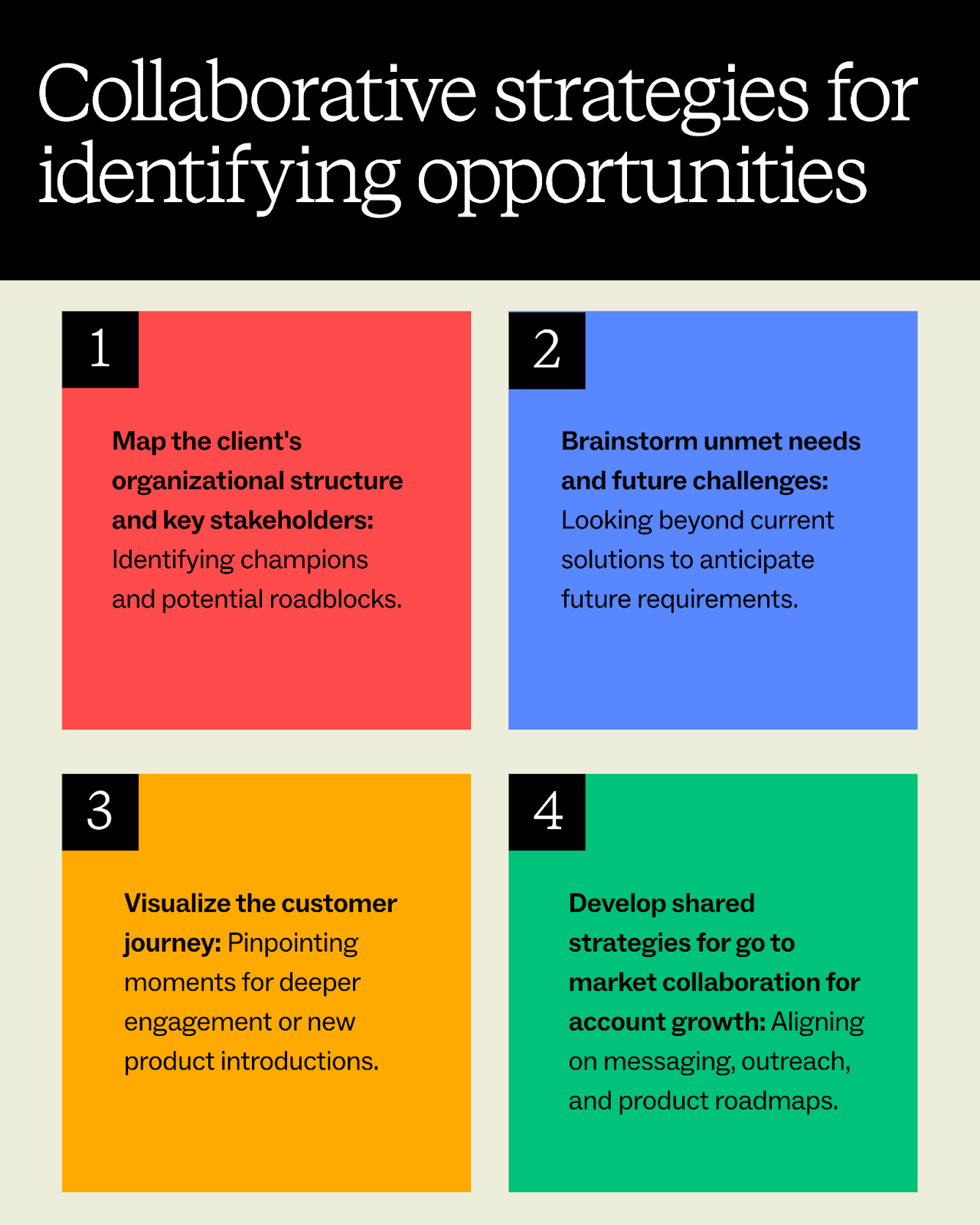The most promising revenue opportunities aren't hiding in your prospect pipeline—they're sitting right under your nose in existing client accounts. Sustainable business growth hinges on your ability to not only acquire new customers but to cultivate and expand your existing customer relationships. This is where strategic account planning can make a huge impact, by transforming your sales approach from transactional to relational.
Impactful account planning isn’t just about account management; it requires reps to proactively identify and follow opportunities within those accounts to unlock new revenue streams. Learning how to identify opportunities within your accounts and act on them quickly is key to becoming indispensable strategic partners to your clients and powerful drivers of your organization's success.
Key highlights:
- Strategic account planning: Move beyond reactive sales to proactive, long-term customer relationship development.
- Cross-functional alignment: Foster seamless collaboration between sales, marketing, and R&D to spot and act on hidden revenue streams.
- Actionable growth: Implement concrete steps and utilize the right visual collaboration tools to capitalize on identified opportunities.
Why account planning is your growth engine
Account planning shouldn’t just be another task on your sales checklist; strategic account planning is the secret to business development that fuels long-term sales growth and client retention. It shifts the focus from singular transactions to customer lifecycle management in which you and your team continuously add value and uncover new avenues for expansion.
Understanding the core of strategic account management
Strategic account management means understanding your key customers’ business objectives, challenges, and aspirations. It requires a systematic approach to anticipating their needs, identifying potential pain points, and positioning your solutions as integral to their success. When you understand your customers’ needs, you become more of a trusted advisor than just a vendor. For a deeper dive into effective strategies, check out this resource on account planning tools, strategies, and solutions for growth.
Shifting from transactional to relational selling
The transactional sales model is quickly becoming a relic. Modern business growth demands a relational approach, where building enduring partnerships is more important than collecting new customers. Account planning provides the framework for this shift. By dedicating time to understanding the client's evolving landscape, you can identify upselling opportunities and cross-selling strategies that genuinely benefit them, rather than simply being a product-pusher. This commitment to their success not only drives business growth for your organization but also significantly enhances client retention, creating a virtuous cycle of mutual benefit.
Beyond the sale: Spotting untapped potential
The initial sale is just the beginning. As your relationship with your client develops, unforeseen opportunities will prevent themselves; keep a keen eye, a strategic mindset, and a collaborative spirit to make sure you’re ready and prepared when they arise.
Techniques for opportunity identification
Effective opportunity identification begins with taking a close look at your client's business. Consider customer journey mapping to understand every touchpoint and potential friction point. Conduct thorough whitespace analysis to pinpoint where your current offerings don't fully cover your client’s needs or where your clients might be using competitor products. Look for changes in their market, new initiatives they've announced, or shifts in their leadership. These can all signal nascent opportunities where you can help. Be proactive and curious, asking insightful questions that go beyond their immediate stated needs to uncover opportunities that might not be immediately apparent.
Leveraging data for deeper insights
A close analysis of the right kind of data can help uncover new opportunities. CRM systems, sales intelligence platforms, and even public company reports offer a treasure trove of information. Analyze purchase history, engagement metrics, support tickets, and industry trends to spot patterns and predict future needs.
Data can illuminate areas where your product or service could provide additional value, reveal underserved departments, or indicate potential market expansion opportunities within your client’s operations. Visualizing your data in a visual collaboration platform like Mural can make insights more apparent to your team and be a valuable tool when making the case to your clients. Many sales teams use the MEDDIC framework (standing for “Metrics, Economic Buyer, Decision Criteria, Decision Process, Identify Pain”) to build in-depth profiles of their customers; take a look at Mural’s MEDDIC template to see how this framework could work for you.
Collaborative strategies for identifying opportunities
Opportunity identification isn't a solo endeavor. It’s at its best when you have cross-functional alignment and the diverse perspectives brought by sales, marketing, and product development teams. When these groups collaborate seamlessly, they create a powerful engine for uncovering and capitalizing on new revenue streams.
Fostering cross-functional alignment
Cross-functional alignment is important to maximizing business growth from existing accounts. Sales teams bring intimate knowledge of individual client needs, marketing offers insights into broader market trends and messaging, and product development understands future capabilities and innovation strategy. When these teams come together in a structured way, they can identify new revenue streams together in existing accounts that no single department would spot when working in a silo.
The role of collaborative planning sessions
Cross-functional collaboration is where the right visual collaboration platform can make a big difference. Imagine sales, marketing, and R&D teams in a shared digital workspace, collectively reviewing an account, brainstorming upselling opportunities, or mapping out cross-selling strategies. Visual collaboration tools provide the ideal environment for these sessions, allowing teams to:
- Map the client's organizational structure and key stakeholders to identify champions and potential roadblocks.
- Brainstorm unmet needs and future challenges, looking beyond current solutions to anticipate future requirements.
- Visualize the customer journey to pinpoint moments for deeper engagement or new product introductions.
- Develop shared strategies for go-to-market collaboration for account growth. Aligning on messaging, outreach, and product roadmaps.

Cross-functional collaboration sessions foster a shared understanding and collective ownership of account growth. An account planning template for identifying growth opportunities can be helpful in getting the most out of these sessions.
Actionable steps to capitalize on growth
Identifying opportunities is only half the battle; the real win comes from effectively capitalizing on them. This involves clear planning, a robust go-to-market strategy, and continuous refinement.
Developing a strategic account plan
Once opportunities are identified, the next step is to integrate them into a comprehensive strategic account plan. This plan should detail the specific revenue streams you aim to unlock, the resources required, the timeline, and clear responsibilities for each team member. Develop a strategic account plan for customer expansion that's both ambitious and achievable. Don't forget to include key performance indicators (KPIs) to track progress.
Need help structuring your plan? Explore effective key account plan formats and strategies.
Executing with cross-functional coordination
Execution demands precision and cross-functional alignment. Sales leads the client interactions, marketing provides the necessary collateral and campaigns, and product teams ensure the solutions are ready and tailored. Regular check-ins and shared progress dashboards (easily facilitated by visual collaboration tools) are crucial to ensure everyone is moving in the same direction.
Measuring success and sustaining momentum
Growth isn't a one-time event; it’s an ongoing process that requires continuous monitoring, evaluation, and adaptation. Measuring success and sustaining momentum are vital for long-term business growth.
Key metrics for tracking opportunity growth
To ensure your opportunity identification efforts are truly impactful, you need to track the right metrics. Beyond overall sales growth and revenue streams, consider:
- Opportunity conversion rate: How many identified opportunities turn into closed deals?
- Average deal size from existing accounts: Are you successfully expanding the value of each client?
- Client lifetime value (CLV): Is your strategic approach increasing the long-term profitability of your relationships?
- Cross-sell/upsell revenue: Specific metrics to track the success of these targeted initiatives.
- Customer satisfaction scores: Happy customers are more likely to present new opportunities.
These metrics provide a clear picture of your effectiveness and help refine your strategic account management approach.
Iterative improvement through account reviews
Finally, to sustain momentum and ensure continuous improvement, conduct regular account reviews. These are structured sessions where your cross-functional team evaluates what worked, what didn't, and why. They're opportunities to refine your strategies for cross-functional alignment in account planning, adapt to changing client needs, and incorporate new insights. An iterative process is key to long-term business growth and ensures your account planning remains dynamic and effective.
Learn more about running an effective account review to maximize these sessions.
Account planning is much more than a routine task; it's a strategic imperative for unlocking unparalleled business growth. By embracing opportunity identification through deep customer relationships, fostering cross-functional alignment, and leveraging collaborative planning with powerful tools, you can transform your existing accounts into endless sources of new revenue streams. This holistic approach ensures not just a momentary boost but truly sustainable growth that positions your organization for long-term success.
Ready to unlock your accounts' full potential? Explore our interactive templates for account planning and collaborative opportunity identification.
FAQs
Q: What's the main difference between traditional selling and strategic account planning?
A: Traditional selling is often transactional and short-term focused. Strategic account planning, by contrast, builds long-term, relational partnerships, focusing on continuous opportunity identification and sustainable growth within existing customer relationships.
Q: How does cross-functional alignment contribute to identifying new revenue streams?
A: Cross-functional alignment brings together diverse perspectives from sales, marketing, and R&D. This collaborative approach, often supported by visual collaboration tools, allows teams to collectively uncover new needs, upselling opportunities, and cross-selling strategies that a single department might miss, leading to expanded revenue streams.
Q: What are the immediate steps to start leveraging existing customer relationships for growth?
A: Begin by conducting a thorough whitespace analysis and customer journey mapping for your key accounts. Then, organize a collaborative planning session with your go to market teams to identify specific opportunity identification points, leading to a refined strategic account plan for business growth.










